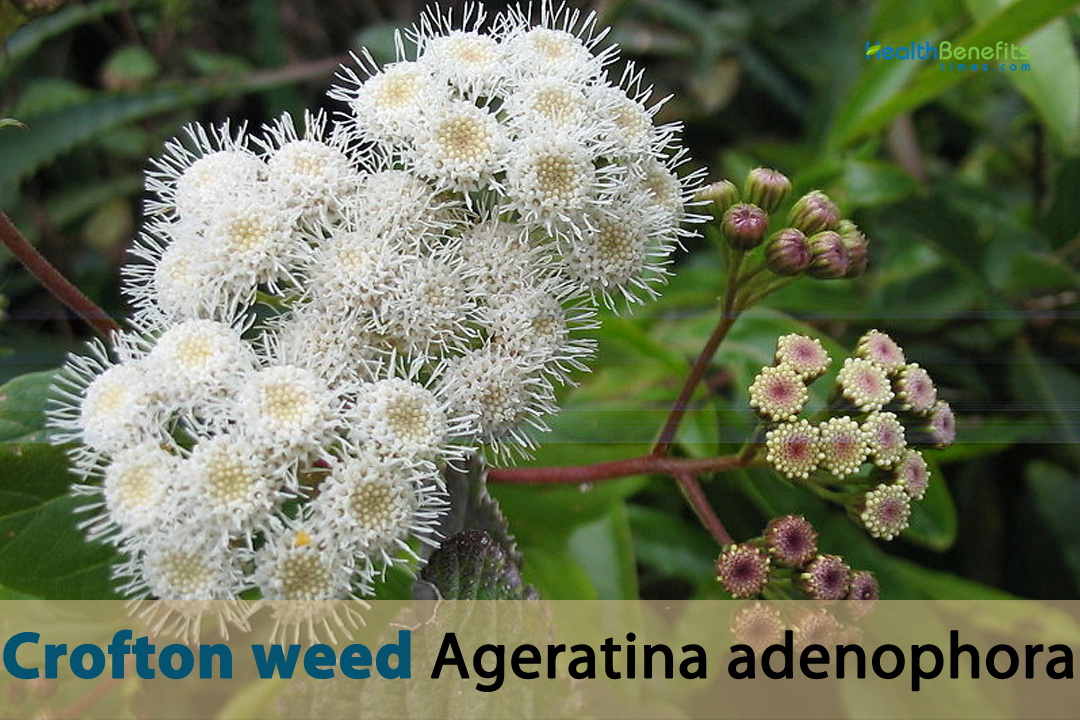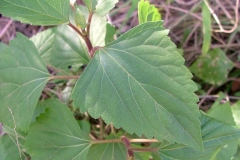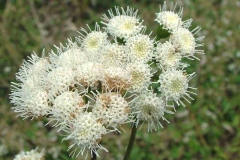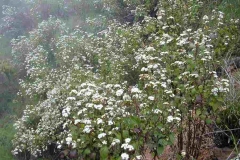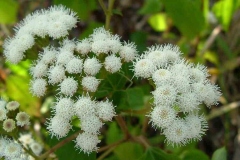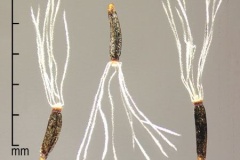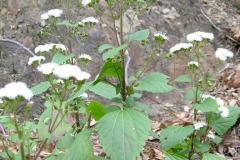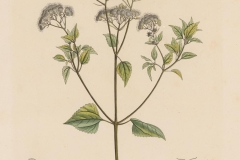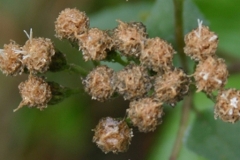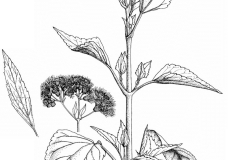| Crofton weed Quick Facts | |
|---|---|
| Name: | Crofton weed |
| Scientific Name: | Ageratina adenophora |
| Origin | Mexico and Central America |
| Colors | Either reddish-brown or blackish-brown |
| Shapes | Achenes are angular, thin, slightly curved 1-2 mm long and 0.3-0.5 mm wide |
| Taste | Bitter, acrid |
| Health benefits | Treat wounds, itching, measles, dysentery, skin conditions, and uterine bleeding, control bleeding from cuts |
| Name | Crofton weed |
|---|---|
| Scientific Name | Ageratina adenophora |
| Native | Originally from Mexico and Central America, this species is now a worldwide invasive. It is on the official state noxious weeds list in the USA and in parts of Australia |
| Common Names | Cat weed, crofton weed, hemp agrimony, Mexican devil, sticky agrimony, sticky eupatorium, sticky snakeroot, white thoroughwort, eupatory, sticky snakeroot, Maui pamakani, Catspaw, Glandular eupatorium, pamakani |
| Name in Other Languages | Australia: Catweed, hemp agrimony, Mexican devil, sticky agrimony Chinese: Jiǎ huò xiāng jì (假藿香薊), po huai cao (破坏草), Zǐ jīng zé lán (紫茎泽兰) English: Maui pamakani, Mexican devil, Sticky snakeroot, Catweed, Crofton weed, Hemp-agrimony, Sticky-agrimony, Catspaw, White Thoroughwort, Glandular eupatorium, pamakani, sticky snakewort, sticky eupatorium Finnish: Nystyvalkolatva French: Agératine du Mexique, eupatoire blanc German: Klebrige Natternwurz, drüsentragender Wasserdost Hawaiian: Maui pāmakani, pāmakani haole India: Cypress Weed Malayalam: Neelagiri, Thravada, communista pachcha (കമ്മുണിസ്റ്റ പച്ച) Manipuri: Japan napi, Japan opro Marathi: Osadi (ओसाडी) Mizo: Bihar-hlo, Midum-hlo Nepali: Kaaleemunte (कालीमुन्टे), Banmara (बनमारा) New Zealand: Catweed, hemp agrimony, Mexican devil Portuguese: Abundáncia, inça-muito Russian: Ageratïna jelezïstaya (Агератина железистая) Spanish: Flor de Espuma, ageratina, espumilla, hediondo Thai: S̄āb h̄mā (สาบหมา) USA: Sticky agrimony, sticky snakeroot USA/Hawaii: Maui pamakani |
| Plant Growth Habit | Long-lived, evergreen, perennial, herbaceous plant or small soft-stemmed shrub |
| Growing Climates | Dry to wet forests, river banks, swampy sites, grassland, disturbed places, roadsides, bush land edges, along watercourses, creeks, wetlands, forest edges, shrub lands, stream sides, open forest, gum lands, slips, alluvial flats, coast and estuaries, railway embankments, nature reserves, national parks, waste areas, ungrazed smallholdings, cleared land, fence lines and abandoned banana plantations |
| Soil | Plant is not particularly fussy about soil types, thriving in sandy, loamy, and clay soils. It prefers well-drained soils with a pH range from slightly acidic to neutral |
| Plant Size | 1 or 2 meters (3.3 or 6.6 ft) high |
| Stem | Stems are young, they are heavily coated in glandular, or sticky, hairs that might have a green, reddish, or purplish hue |
| Leaf | Opposite trowel-shaped serrated leaves that are 6–10 cm (2.4–3.9 in) long by 3–6 cm (1.2–2.4 in) in width |
| Flowering season | August, September, October, November, December, January, February, March |
| Flower | Small compound flowers occur in late spring and summer, and are found in clusters at the end of branches. Each flowerhead is up to 0.5 cm in the diameter and creamy white |
| Fruit Shape & Size | Achenes are angular, thin, slightly curved 1-2 mm long and 0.3-0.5 mm wide |
| Fruit Color | Either reddish-brown or blackish-brown |
| Taste | Bitter, acrid |
| Plant Parts Used | Leaf |
| Season | September–December |
| Propagation | By seeds |
Plant Description
Long-lived, evergreen, perennial, herbaceous, and with a maximum known height of approximately 3 meters, Crofton weed usually reaches a height of 1 to 2 meters. Generally speaking, it grows a few millimeters every month, depending on the surroundings. The plant can displace native species and change the structure of the soil due to its fibrous roots, which can spread far and cause issues. The plant grows in a variety of habitats, including dry to wet forests, riverbanks, swampy areas, grasslands, disturbed areas, roadsides, borders of shrubs and trees, wetlands, creeks, wetlands, open forests, gum lands, slips, alluvial flats, coast and estuaries, railway embankments, waste areas, ungrazed smallholdings, cleared land, fence lines, and abandoned estates that produced bananas. The plant grows well in clay, loamy, and sandy soils and is not very picky about them. It favors soils with a pH range of neutral to slightly acidic that drain effectively.
Stem
When the branched stems are young, they are heavily coated in glandular, or sticky, hairs that might have a green, reddish, or purplish hue. When they reach maturity, they become slightly woody and take on a brownish-green or brown hue. An adventitious root may emerge on the first 3 cm of the stem. Stems originate from a short, thick, pale-yellow rootstock that smells like carrots when broken. Numerous branching secondary roots spread laterally to a radius of 1 m and downward to 40 cm.
Leaves
The leaves are carried on stalks, or petioles, that are 1-6 cm long and placed in opposition to one another along the stems. The leaf blades have bluntly or severely serrated (i.e., crenate or serrate) margins and are trowel-shaped, diamond-shaped (i.e., rhomboid), or triangular in shape. They measure 4–15 cm long and 3–9 cm broad. These leaves are glabrous (usually hairless) with acute apices, or sharp points, but their petioles, or stalks, are sometimes covered in sticky hairs, making them glandular pubescent.
Flowers
The little flower-heads, or capitula, are made up of multiple small flowers, or tubular florets, encircled by two rows of 3-5 mm long greenish bracts, or an involucre. The small flower-heads lack big “petals,” or ray florets. Large numbers of these 5-8 mm wide flower-heads are carried in clusters at the tips of the branches, resembling terminal corymbose inflorescences. The 3-5 mm long, white, tubular florets are bisexual since they have both male and female flower components. In northern locations, flowering typically takes place in the spring and early summer, whereas in southern regions, it happens in the late summer and fall.
Fruit
Achenes, or fruits, are angular, thin, slightly curved, and colored either reddish-brown or blackish-brown. The seeds are 1-2 mm long and 0.3-0.5 mm wide, with four or five little ribs running lengthwise, or longitudinally, and a hairless (glabrous) body. They do, however, have a ring (pappus) at the top made up of many tiny, easily shed white hairs that are 3–4 mm long.
History
Although it originated in Mexico, coral weed has spread to many other nations. Since its introduction as an ornamental in the nineteenth century, it has become established as an invasive weed in many subtropical regions of the world, including Africa (Nigeria, Zimbabwe, and South Africa), Oceania (Hawaiian Islands, Tahiti, New Zealand, Australia, and Papua New Guinea), Asia (India, Nepal, China, the Philippines, Thailand, and Brunei), and Europe (France, Greece, Portugal, and Spain). Captain James Makee brought it to the Hawaiian island of Maui in 1860 as a decorative plant, and it soon spread to roadsides and rangelands.
Health benefits
- Traditional medicines use the leaves of the sticky snakeroot, also known as crofton weed, to treat a variety of ailments.
- They have antibacterial and astringent properties and are used to treat wounds, itching, measles, skin conditions, and uterine bleeding.
- Root extract is given to treat fever, and leaf extract is used to control bleeding from cuts and wounds and create clots.
- In addition to treating sleeplessness, leaf juice is applied topically to cure dysentery.
Different Uses
- Composting Material: Crofton weed’s high biomass production and quick growth make it a suitable resource for green compost. It breaks down into a nutrient-rich compost when combined with other composting components, which can improve soil fertility and health.
- Allelopathic Properties: Allelopathic means that the plant has the ability to release substances that prevent other plants from growing around it. In managed agricultural settings, this trait can be used to suppress weeds, although careful control is needed to avoid detrimental effects on intended crops.
- Honey Production: Honeybees can obtain nectar from the flowers of Crofton weed in areas where it is not considered an invasive species. The plant can aid in the production of honey in the area, albeit the honey’s flavor and quality may differ.
- Pest Management: Crofton weed offers a home for predatory insects and other natural enemies of agricultural pests, therefore it can be useful in integrated pest management (IPM) tactics. To make sure that it doesn’t end up serving as a host plant for pests, this use needs to be closely monitored.
- Landscaping and Garden Mulch: In landscaping projects, Crofton weed’s dense leaves can be utilized as a living mulch to keep soil moisture in check, restrict plant growth, and create ground cover. However, because of its potential for invasion, its use for this purpose should be addressed cautiously.
- Study of Invasive Species Dynamics: The efficacy of different control strategies, the dynamics of invasive species, and their effects on ecosystems can all be studied using the common organism, crofton weed. These studies may also shed light on how to manage invasive species of other kinds.
Prevention and Control
When thinking about chemical control, you should check your country’s national list of registered pesticides or the appropriate government to find out whether products are lawfully permitted for use there due to the inconsistent restrictions surrounding (de)registration of pesticides. It is important to always apply pesticides legally and in accordance with the directions on the label.
Mechanical Control
When possible, slashing, ripping, or plowing should be done to reduce crofton weed before planting a pasture with legumes and tropical grasses that are appropriate for the area. Although it may be challenging to establish planted pastures in the spring before the weeds germinate in the summer due to unpredictable rainfall patterns, improving pastures is likely the most successful form of control. When wheeled tractors cannot be used safely, slash and cultivate infested regions in the early spring utilizing crawler tractors and tandem offset discs. High-rate sow the pasture mixture, and spot-treat seedlings as they emerge.
Chemical Control
Applying glyphosate, dicamba + MCPA, or picloram + triclopyr in large quantities during late summer or early fall, when the weed is actively growing, and completely soaking the entire plant, especially the base, is an effective method of chemical management. If the slope allows, utilize a gas cannon to deliver low volume, high concentration treatments of picloram + triclopyr, or treat scattered plants with granular herbicide formulations in less accessible, steep, or rocky regions. Boom spray denser infestations with dicamba + MCPA.
Biological Control
Procecidochares utilis, a trypetid gall fly, was brought to Queensland, Australia, in 1952 as a result of the trypetid weed’s relative success in Hawaii, USA, with biological control. It was effectively planted, but because native hymenopteran insects parasitized it, the extent of the harm varied. Additionally, a local cerambycid that bores crowns, Dihammus argentatus, and an alien fungus called Cercospora eupatorii attack crofton weed. The combined influence of these organisms has diminished plant vigor, but none of them provides any meaningful degree of control on its own. In Hawaii, USA, biological control was first implemented. Osborne conducted a survey of the weed’s natural enemies within its native habitat in Mexico, and in 1945 the gall fly P. utilis was introduced. All areas saw successful weed removal, with the exception of some all locations saw successful weed management, with the exception of those with yearly rainfall above 1030–1540 mm. The gall fly was brought to the Indian foothills of the Himalayas in 1963, along with a particular leaf spot disease caused by Mycovellosiella sp.; however, its influence has been lessened by parasitism by native parasitoids. When the weed spread throughout China, the gall fly was brought in from the Nepali border and released in Yunnan Province and then Sichuan Province, but the high parasitism has produced unsatisfactory results. Additionally, attempts at biological management have been made in South Africa and New Zealand, where the fungus and gall fly are well-established, but the weed has not responded well to these attempts.
Side effects
Horses that eat crofton weed get a chronic lung ailment in northern New South Wales and Queensland called Numinbah Horse Sickness or Tallebudgera Horse ailment.
References:
https://www.itis.gov/servlet/SingleRpt/SingleRpt?search_topic=TSN&search_value=36465#null
http://www.hear.org/pier/species/ageratina_adenophora.htm
https://www.cabidigitallibrary.org/doi/10.1079/cabicompendium.23243
https://gd.eppo.int/taxon/EUPAD
https://en.wikipedia.org/wiki/Ageratina_adenophora
https://biodiversity.bt/species/show/3949
https://indiabiodiversity.org/species/show/228664
https://www.flowersofindia.net/catalog/slides/Catweed.html
https://www.nzpcn.org.nz/flora/species/ageratina-adenophora/
https://plants.usda.gov/home/plantProfile?symbol=AGAD2


